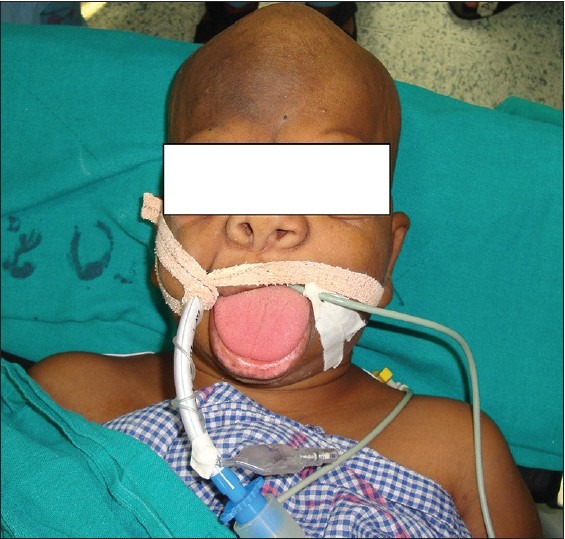Sir,
GAPO syndrome is an autosomal recessive disorder and is associated with Growth retardation, Alopecia, Pseudoanodontia and Optic atrophy.[1] Here, we describe the anesthesia management of a case of 20 years female with diagnosis of GAPO syndrome who underwent craniosynostosis repair under general anesthesia. She had history of noisy breathing and obstructive sleep apnea (OSA). She was short in stature with a weight of 20kg, trigonocephaly, large tongue, exophthalmos, alopecia, and short neck [Figure 1]. She was edentulous with a large tongue and had Mallampati Grade IV score. Her neck was in a flexed position and extension was restricted. She was irritable and had difficult venous access. Cardiovascular and respiratory systems were normal. Routine investigations were normal. Lumbar puncture showed a cerebrospinal fluid (CSF) pressure of 26cmH2 O. Intravenous (IV) access was secured after induction of anesthesia with incremental concentration of sevoflurane. Rocuronium 25mg was given to facilitate endotracheal intubation. To decrease intracranial pressure (ICP), hyperventilation and 50mgIV thiopentone was given at the time of induction. Anesthesia was maintained with oxygen, nitrous oxide, sevoflurane, fentanyl and vecuronium. Intraoperative monitoring included electrocardiography and noninvasive blood pressure, invasive blood pressure, pulse oximetry, capnography, temperature and central venous pressure monitoring. During flap removal, 100ml of 20% mannitol was administered. Neuromuscular blockade was reversed and trachea extubated when she was fully awake with good respiratory efforts. Thirty minutes after extubation, patient developed respiratory distress and SpO2 became 62%. Patient was reintubated and put on ventilator for 2 days. Five hours after extubation, her sensorium deteriorated and she required reintubation and ventilation. Subsequently, she remained tracheostomized for 12 days. Patient was discharged home on 20th postoperative day. In view of difficult venous access, uncooperative patient and anticipated difficult airway, we opted for an inhalational induction. Though the patient was awake and had good breathing efforts before each extubation, she required reintubation. This was most likely due to airway obstruction secondary to residual effect of anesthesia in the immediate postoperative period and diminished pulmonary function in the next occasion. Airway obstruction got aggravated due to the presence of OSA, large tongue, and flexed neck. Patients with GAPO syndrome may have other systemic anomalies such as dilated cardiomyopathy,[2] pulmonary hypertension,[3] intracranial vascular malformations,[4] glaucoma,[5] and optic atrophy.[5] Anesthetic management of these cases should therefore, begin with a careful history and special attention to facial deformities, cardiorespiratory system, and associated congenital anomalies. Signs of raised ICP such as visual difficulties, nausea and vomiting, somnolence, or headaches should be noted. If ICP is raised, then adequate measures should be taken to prevent further rise in ICP. A difficult intubation trolley should always be ready in the operation theater before induction of anesthesia. Proper eye care should be given to patients with exophthalmos to prevent ophthalmic injury under anesthesia. These patients should be extubated only when they are fully awake and have good cough reflex. Patient should be closely monitored in the postoperative period for occurrence of respiratory obstruction, hypoventilation, hypoxia, and the possible need for reintubation.
Figure 1.

The patient with alopecia, craniosynostosis, large tongue, and retrognathia
References
- 1.Tipton RE, Gorlin RJ. Growth retardation, alopecia, pseudo-anodontia, and optic atrophy: The GAPO syndrome: Report of a patient and review of the literature. Am J Med Genet. 1984;19:209–16. doi: 10.1002/ajmg.1320190202. [DOI] [PubMed] [Google Scholar]
- 2.Kocabay G, Mert M. GAPO syndrome associated with dilated cardiomyopathy: An unreported association. Am J Med Genet A. 2009;149A:415–6. doi: 10.1002/ajmg.a.32638. [DOI] [PubMed] [Google Scholar]
- 3.Demirgüneº EF, Ersoy-Evans S, Karaduman A. GAPO syndrome with the novel features of pulmonary hypertension, ankyloglossia, and prognathism. Am J Med Genet A. 2009;149A:802–5. doi: 10.1002/ajmg.a.32686. [DOI] [PubMed] [Google Scholar]
- 4.Castrillon-Oberndorfer G, Seeberger R, Bacon C, Engel M, Ebinger F, Thiele OC. GAPO syndrome associated with craniofacial vascular malformation. Am J Med Genet A. 2010;152A:225–7. doi: 10.1002/ajmg.a.33192. [DOI] [PubMed] [Google Scholar]
- 5.Mullaney PB, Jacquemin C, al-Rashed W, Smith W. Growth retardation, alopecia, pseudoanodontia, and optic atrophy (GAPO syndrome) with congenital glaucoma. Arch Ophthalmol. 1997;115:940–1. doi: 10.1001/archopht.1997.01100160110028. [DOI] [PubMed] [Google Scholar]


